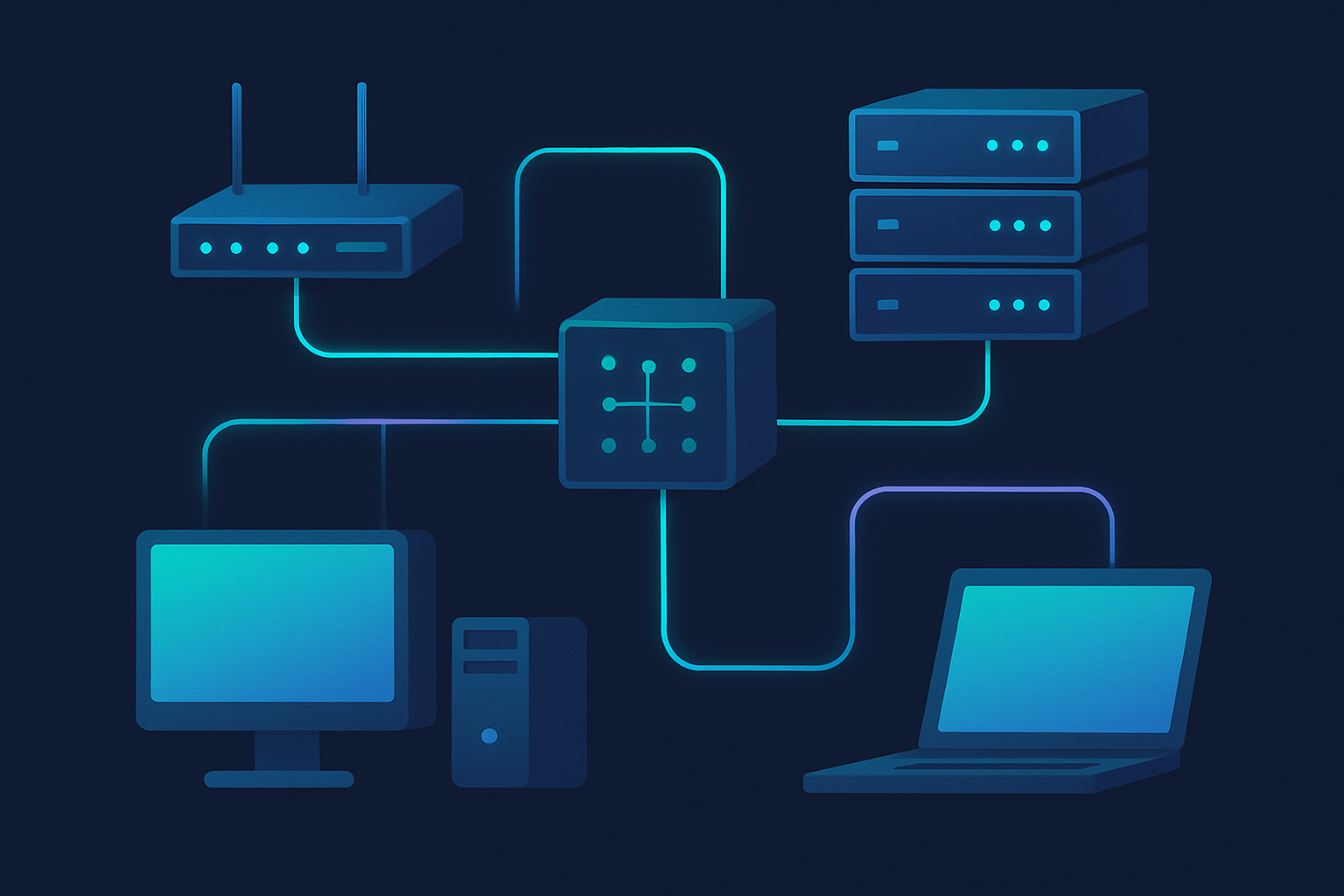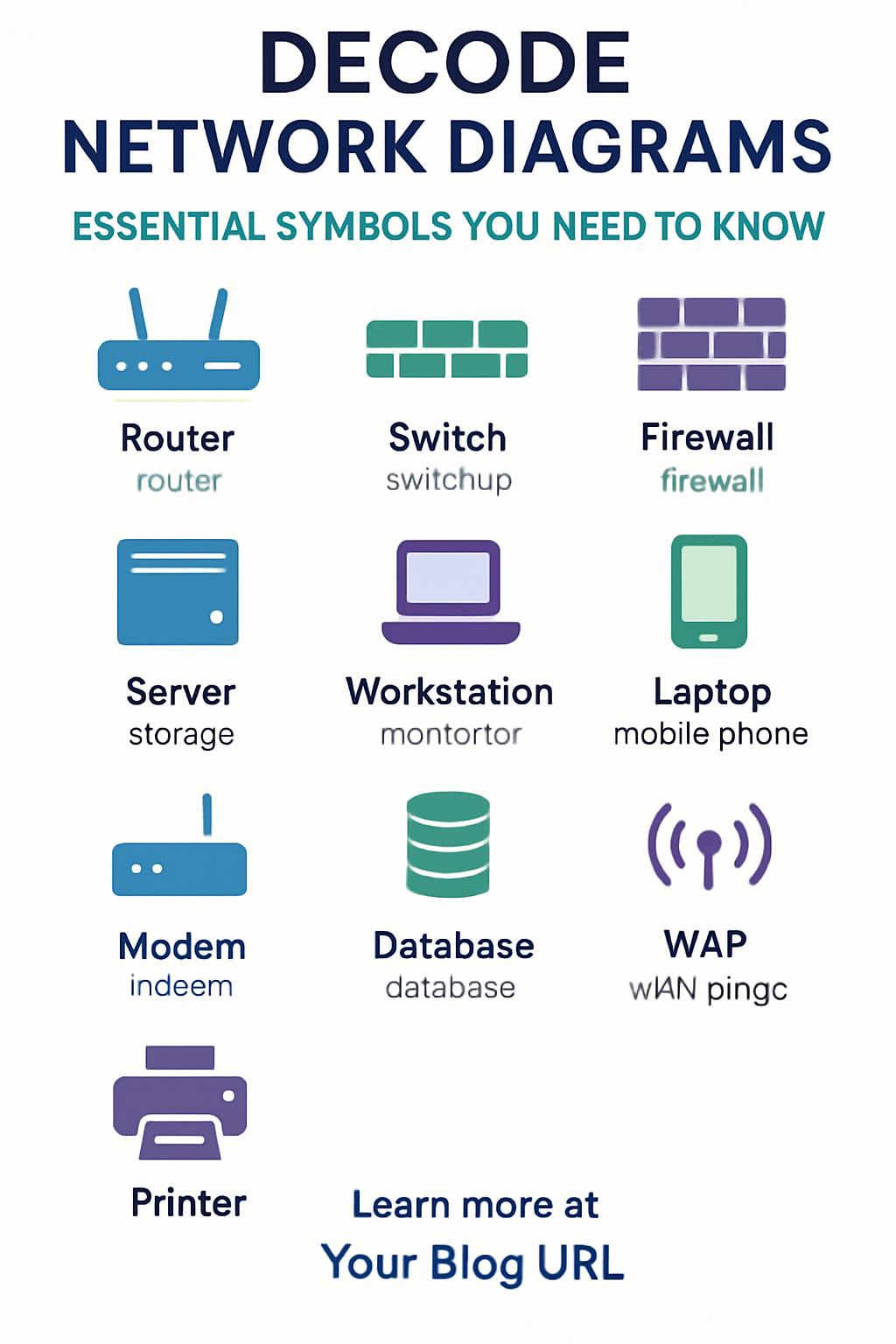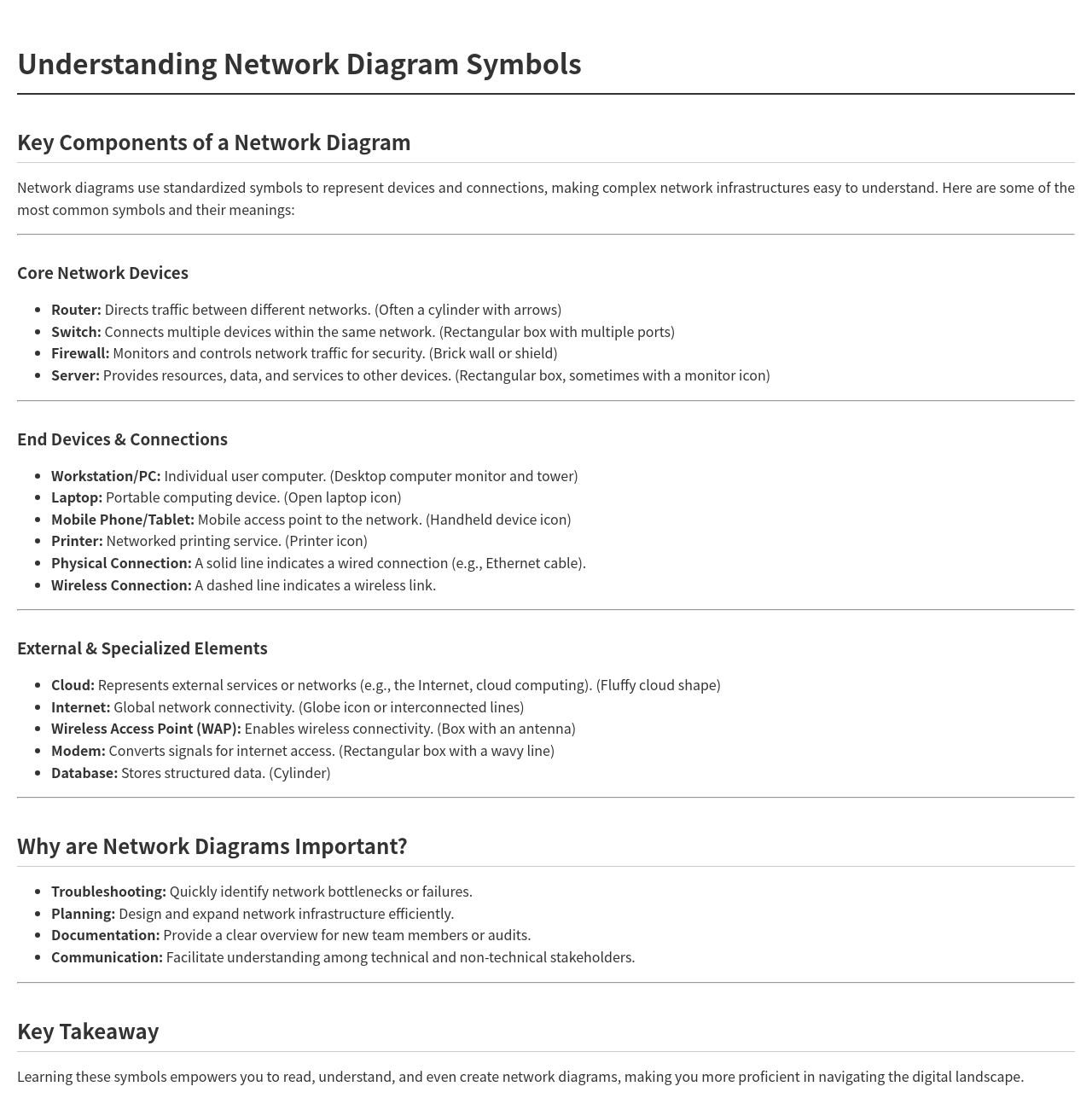
Have you ever looked at a network diagram and felt like you were staring at a secret code?
You’re not alone!
Network diagrams are essential tools for IT professionals, but for the uninitiated, they can seem like a jumble of lines and obscure shapes.
But what if I told you that each of those shapes has a specific meaning,
a story to tell about how your network is built and how it functions?
Understanding these symbols is the first step to truly grasping the architecture of any network, whether it’s a small home setup or a vast corporate infrastructure.
In this comprehensive guide, we’re going to pull back the curtain and reveal the meanings behind the most common network diagram symbols.
By the end of this post, you’ll be able to look at a network diagram and understand its core components, making you a more informed user or even empowering you to troubleshoot basic network issues.
Let’s dive in and decode the language of network diagrams together!
The Foundation: Basic Network Device Symbols
Let’s start with the building blocks of almost any network diagram.
These are the symbols you’ll encounter most frequently, representing the core hardware that makes communication possible.

Videos you see are added as random thoughts 💭 💭 💭
Routers: The Traffic Cops of Your Network
Perhaps one of the most recognizable symbols, the router, often depicted as a cylinder with four arrows pointing in different directions, is crucial for directing traffic between different networks [1].
Think of it as the traffic cop, ensuring data packets find their way from your home network to the internet, or between different departments in a large organization.
Routers are smart devices that analyze network addresses to determine the best path for data to travel.
They can also facilitate wireless access points, making them incredibly versatile.
Switches: Connecting Devices Within a Network
While routers connect different networks, switches connect multiple devices within the same network.
The symbol for a switch is typically a rectangular box with several lines extending from it, representing its multiple ports [2].
If you have several computers, printers, and other devices in your office all needing to communicate with each other,
a switch is what makes that direct communication possible.
It learns the addresses of connected devices and forwards data only to the intended recipient, making your network more efficient.
Firewalls: Your Network’s Security Guard
In today’s interconnected world, security is paramount.
That’s where firewalls come in. Represented often as a brick wall or a shield,
a firewall acts as a barrier, monitoring and controlling incoming and outgoing network traffic based on predetermined security rules [2].
It’s like having a vigilant security guard at the entrance of your network, only allowing authorized traffic to pass through and blocking anything suspicious.
Understanding where firewalls are placed in a diagram gives you a quick insight into the network’s security posture.
Servers: The Heart of Data and Services
Servers are the workhorses of any network, providing resources, data, and services to other devices.
The symbol for a server is usually a rectangular box, sometimes with a small monitor icon on top, or a more generic server rack representation [2].
You might see different types of servers, like a file server (for storing and sharing files), a communication server (for handling communication applications), or a database server (for managing shared data).
Each plays a vital role in keeping operations running smoothly.
Connecting the Dots: Connectors and End Devices
Beyond the core infrastructure, network diagrams also illustrate how these devices are linked and what kind of end-user equipment is involved.
These symbols help visualize the flow of information and the points of interaction within the network.
Connectors: The Pathways of Data
To show the path that data travels within your network diagram, you’ll use connector shapes.
These are typically lines, but their appearance can vary to indicate different types of connections.
A solid line often represents a physical connection, like an Ethernet cable.
Dashed lines might indicate a wireless connection or a logical link.
The type of connector used can provide valuable information about the network’s physical and logical layout.
End Nodes: Where the Network Meets the User
End nodes represent the devices that users interact with directly.
These can include a wide variety of equipment, each with its own distinct symbol:
Workstations/PCs: Often depicted as a desktop computer monitor and tower, these represent individual user computers.
Laptops: A symbol resembling an open laptop signifies portable computing devices.
Mobile Phones/Tablets: Icons resembling these handheld devices indicate mobile access points to the network.
Printers: A printer icon shows where printing services are available on the network.
IP Phones: A symbol of a telephone with an IP address indicates voice communication over the network.
These end-node symbols are crucial for understanding who and what is connected to the network, and how they are accessing its resources.
They bring the abstract network diagram down to a more relatable, human level.
Beyond the Local Network: Cloud and Internet Symbols
As networks become more interconnected and rely heavily on external services, symbols representing the internet and cloud services have become increasingly important.
These symbols help visualize connections that extend beyond your immediate physical infrastructure.
The Cloud: A World of Remote Services
The cloud, typically represented by a fluffy cloud shape, signifies the dividing point between your local network and external services hosted on the internet [2].
This can include anything from cloud storage and applications to entire virtual infrastructures.
When you see a cloud symbol in a diagram, it indicates that certain services or data are not physically located within the depicted network but are accessed remotely.
It simplifies complex external networks into a single, understandable entity.
The Internet: The Global Network
While sometimes implicitly covered by the cloud symbol, the internet can also be represented by a globe icon or a series of interconnected lines.
This symbol emphasizes the global reach and connectivity of the network, indicating that communication extends to external networks worldwide.
It’s a reminder that your local network is just one small part of a much larger, interconnected digital world.
Specialized Network Devices: Beyond the Basics
As networks grow in complexity, so does the variety of devices that comprise them.
Here are some specialized symbols you might encounter, each representing a unique function within the network.
Hubs: The Simple Connectors
Before switches became prevalent, hubs were common for connecting multiple devices in a network.
A hub is often depicted as a rectangular box with multiple ports, similar to a switch, but it functions differently.
Unlike a switch, a hub simply broadcasts all incoming data to every connected device, making it less efficient and less secure than a switch.
While less common in modern networks, you might still see them in older diagrams or very simple setups.
Bridges: Connecting Network Segments
Bridge symbols, often represented by a square or rectangular box with two lines connecting to it, are used to connect two separate network segments, creating a single, larger network.
They operate at the data link layer (Layer 2) of the OSI model and are primarily used to filter traffic between segments, improving network performance.
While switches have largely replaced bridges, understanding their symbol is still valuable for legacy systems or specific network designs.
Wireless Access Points (WAP): Enabling Wireless Connectivity
With the proliferation of wireless devices, the Wireless Access Point (WAP) has become a ubiquitous component.
The symbol for a WAP is typically a box with an antenna, indicating its role in providing wireless connectivity to a cabled network [2].
These devices allow laptops, smartphones, and other wireless gadgets to join the network without physical cables, offering flexibility and mobility.
Modems: Bridging Your Network to the Outside World
A modem (modulator-demodulator) is a device that converts digital signals from your computer into analog signals for transmission over a telephone line, cable, or fiber optic line, and vice-versa.
It’s often depicted as a rectangular box with a wavy line or a telephone jack icon.
The modem is your gateway to the internet, translating the signals so your local network can communicate with your Internet Service Provider (ISP).
Databases: The Storage Houses of Information
Databases are fundamental to almost every application and service running on a network.
Their symbols help illustrate where data is stored and managed.
While a generic database symbol (often a cylinder) exists, more specific symbols can denote different types of databases [2].
Generic Database
The most common symbol for a database is a cylinder, representing a structured collection of data.
This symbol is used when the specific type of database isn’t critical to the diagram’s purpose, or when referring to a general data repository.
Cloud Database
As the name suggests, a cloud database symbol (a cylinder within a cloud shape) indicates a database hosted on a cloud platform.
This means the data is stored and managed remotely, accessible over the internet, offering scalability and flexibility without the need for on-premise hardware.
Database Server
This symbol (often a server rack with a cylinder) represents a dedicated server running database applications.
It signifies a powerful machine optimized for storing, retrieving, and managing large volumes of data, serving multiple clients on the network.
SQL Stretch Database
Specific to Microsoft Azure, this symbol represents a database that can seamlessly store data from a local SQL Server database to an Azure SQL Database.
It’s a hybrid solution for managing growing data needs.

Distributed Database
A distributed database symbol (multiple cylinders connected by lines) indicates a database system where data is stored across multiple physical locations or servers.
This setup enhances availability, fault tolerance, and performance by distributing the workload.
Open-Source Database
This symbol (a cylinder with an open-source logo or a generic open-source icon) represents databases whose source code is freely available,
allowing for customization and community-driven development.
Examples include MySQL, PostgreSQL, and MongoDB.
Operational Database
An operational database symbol signifies a database designed for real-time transaction processing.
These databases are optimized for high-speed data modifications and access, crucial for day-to-day business operations.
Personal Database
While less common in large-scale network diagrams, a personal database symbol might represent a database used by an individual,
often for storing and retrieving large amounts of textual or numeric data on a local machine.
Relational Database
This symbol (a cylinder with interconnected tables) represents a database that organizes data into tables with predefined relationships between them.
Relational databases are widely used due to their structured nature and ability to maintain data integrity.
End-User Database
An end-user database symbol indicates a shared database that end-users can directly access and manipulate without needing to understand the underlying technical operations.
This simplifies data interaction for non-technical users.
Commercial Database
This symbol represents proprietary database systems developed and sold by commercial vendors,
such as Oracle Database or Microsoft SQL Server.
These often come with extensive features, support, and licensing costs
LDAP Symbols: Managing Directories and Access
Lightweight Directory Access Protocol (LDAP) is a protocol used for accessing and maintaining distributed directory information services.
In network diagrams, LDAP symbols help visualize how directory services are structured and how information is shared and authenticated across the network [2].
Organization Symbol
This symbol represents a social unit of people working towards a common goal, often with internal structures and management.
In an LDAP context, it signifies a top-level organizational unit within the directory.
Locality Symbol
The locality symbol depicts a dynamic range for connected devices,
indicating that devices in close proximity can communicate within a network.
In LDAP, it can represent a geographical location or a specific physical site within the directory structure.
Person Symbol
This symbol represents a legal or biological entity within LDAP, typically an individual user or an administrator with specific access rights and attributes stored in the directory.
Group of Names Symbol
This symbol represents dynamic or static groups within LDAP.
These groups are collections of users or other entities that share common characteristics or permissions, simplifying access management and policy enforcement.
DSA Symbol (Directory System Agent)
Directory System Agent (DSA) represents the portion of the directory service that users can access.
It’s the server component that holds the directory information and processes client requests.
DMD Symbol (Directory Management Domain)
The Directory Management Domain (DMD) symbol represents the domain that manages the directory data and communications.
It defines the scope of administrative control over a portion of the directory service.
Conclusion: Your Journey to Network Diagram Fluency
Congratulations! You’ve taken a significant step towards understanding the visual language of network diagrams.
While the world of networking is vast and constantly evolving, mastering these fundamental symbols provides you with a solid foundation.
You can now look at a diagram and begin to decipher the intricate relationships between devices, the flow of data, and the overall architecture of a network.
Remember, practice makes perfect. The more you expose yourself to different network diagrams, the more intuitive these symbols will become.
Don’t be afraid to explore, ask questions, and even try drawing your own simple diagrams.
The ability to read and interpret these visual representations is an invaluable skill in today’s technology-driven world, whether you’re an aspiring IT professional,
a curious tech enthusiast, or simply someone who wants to better understand the digital infrastructure that surrounds us.
Keep learning, keep exploring, and soon you’ll be speaking the language of network diagrams like a seasoned pro!
References
[1] Lucidchart. “Network Diagram Symbols and Icons.” Lucidchart, []()
[2] EdrawMax. “Network Diagram Symbols and Icons.” *EdrawMax Online*, []()
